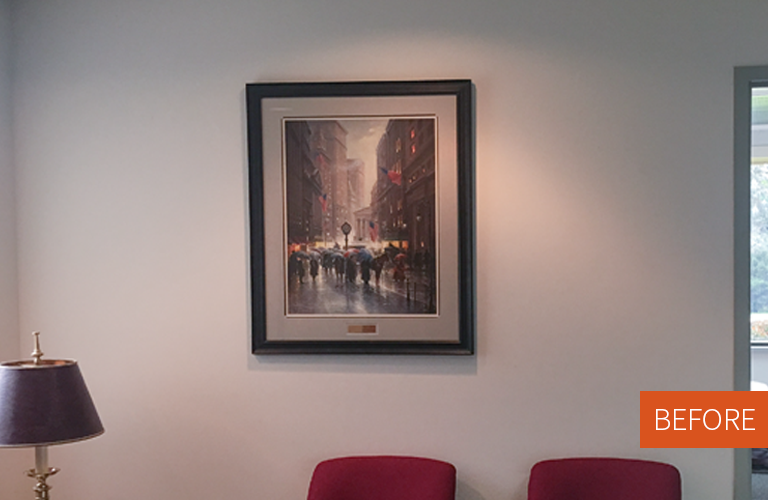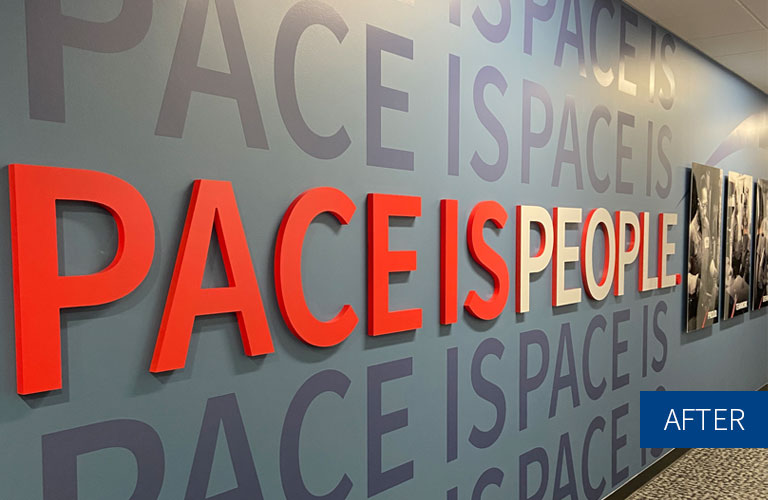
Summary
- Brand culture design is the process of implementing your branding into your environment and it’s not just for large or start-up tech companies anymore.
- Brand culture design can lead to higher employee satisfaction and productivity along with greater customer loyalty, which ultimately, adds to your bottom line.
- You don’t need a large budget to make a big impact in your space.
- We’ve helped several clients transform their spaces through brand culture design – here are just a few examples to check out:
Faurecia Interior Systems | Maxion Wheels | DexKo Global | Pace Industries
Priestap Financial
Living The Brand
We’ve all heard about the amazing perks that come with working at a place like Google. Benefits like free, never-ending gourmet meals, nap pods and bringing your dog to work are a just a part of the everyday norm. In an ultra-competitive industry, Google realized early on that to attract, retain and keep employees happy, you have to create a place where they love to come to work everyday. They had to develop a company culture and brand that was reflective of their core values, mission and vision – and then they had to live it. While companies may now take the time to discuss and define their brand and culture, many miss the opportunity to bring this to life through their spaces. The process of implementing your brand into your environment is what we refer to as “brand culture design” and you should be interested in it even if you’re not Google or a fancy high-tech start-up.
DexKo
Why It’s So Important
It’s actually pretty simple – no matter the business you’re in, you want to add to your bottom line. And how do you do that? Make your customers happy and your employees even happier. Brand culture design can help with both of these goals. Here’s how:
1. A workplace environment not only helps attract new employees, but it also can create happier, more productive employees. A recent study at the University of Warwick found that happiness led to a 12 percent spike in productivity, while unhappy workers were 10 percent less productive. The research team put it like this:
“We find that human happiness has large and positive causal effects on productivity. Positive emotions appear to invigorate human beings. Under scientifically controlled conditions, making workers happier really pays off. Companies like Google have invested more in employee support and employee satisfaction has risen as a result. For Google, it rose by 37 percent. The driving force seems to be that happier workers use the time they have more effectively, increasing the pace at which they can work without sacrificing quality.”
Brand culture design starts with knowing and living your company’s core values, mission and vision.
2. Today’s customers are informed, very smart and want to know that you are who you say you are
Until recently, much of marketing and advertising provided customers with selective and often incomplete and even misleading information. It was nearly unheard-of to communicate anything less than glowingly complimentary about your product or service. Public relations worked hand-in-hand with advertising to ensure that the audience saw a sparklingly positive corporate image, regardless of real shortcomings. And then came the Internet and social media.
Over a very short period of time, in business terms, the public gained the ability to see inside of companies and get much more complete understanding of the pros and cons of the things they sell. Perhaps more importantly, they could share and discuss what they learned with other consumers on Facebook, Twitter and other social media sites.
These days, customers can usually figure out when a brand is not living their promise. One of the quickest ways they do this is when they visit your location. They can gain confidence and affinity for your brand when they can seamlessly connect the dots from your web presence into your physical space. However, if there is disconnect between the two, it creates a cognitive dissonance that may lead to distrust of your brand. When your brand is clear and recognizable in every interaction they have with your company, they not only become more loyal customers, but they also then become advocates for your brand.
Pace Industries
So How Do I Begin?
Clearly, brand culture design can be an all-encompassing initiative, but it doesn’t have to be overwhelming. It should start with your leadership team and marketing staff, who will strategize, plan and guide the execution of the process. Many issues must be considered, from definition of core values, identification of target audiences and long-term objectives to budget, timeline, accountabilities and more. In most cases it is much better to bring in an outside expert to lead the effort, provide vital expertise and attain an objective, outside perspective.
Brand culture design starts with knowing and living your company’s core values, mission and vision. The brand must be consistent with who your company is and what it does. It is multidimensional, comprised of your products, your company and its employees.
Before reaching out to customers, the company must engage its employees, ensuring that its policies and performance are consistent with the brand. Corporate culture is critical. The physical environment and working conditions should also communicate the right message. These things are critical because today’s brand will be hollow if it is not fully embraced, supported and believed in by the company’s employees, who bring it to the customers.
What Does This Actually Mean For My Space?
There are many elements that can be used to express your brand in your environment. Employees, customers, suppliers and others should experience the unmistakably clear message of your brand when they walk through your door. The basic elements include:
- Art and graphics
- Use of space
- Signage
- Video
- Audio presence
- Furniture
- Visibility and partitioning
- Paint
Maxion Wheels
Ok, But I Don’t Have a Huge Budget
It’s helpful to understand that the entire initiative does not need to be implemented at one time. Through careful planning and guidance, it can be phased in, limiting the scope to a workable effort at any point in time. Getting the sequence right makes it possible to put pieces in place over time, ultimately resulting in an engaging, fully-embraced brand culture.
We’ve helped several clients transform their spaces through brand culture design – here are just a few examples:
Want to learn how we can help you live your brand?
Contact us to learn more or to set up a free initial consultation.


















